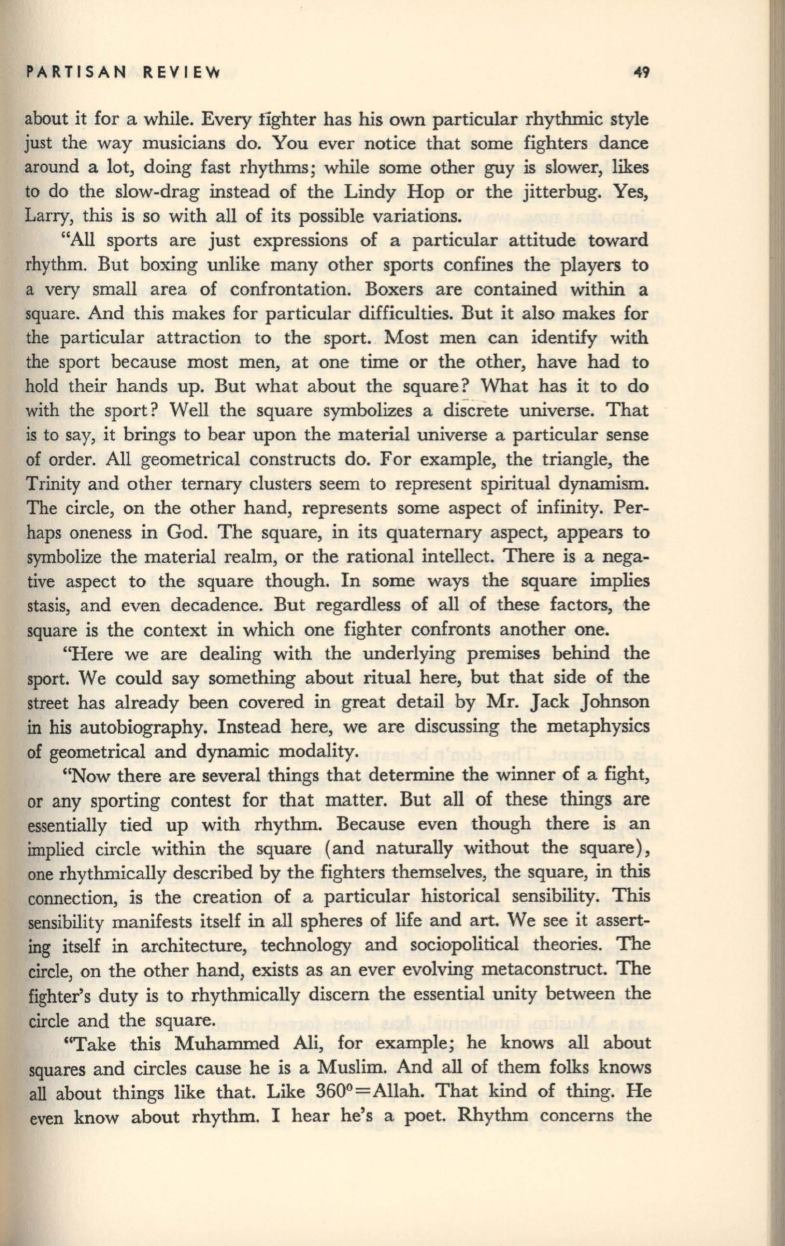
PARTISAN REVIEW
49
about it for a while. Every tighter has his own particular rhythmic style
just the way musicians do. You ever notice that some fighters dance
around a lot, doing fast rhythms; while some other guy is slower, likes
to do the slow-drag instead of the Lindy Hop or the jitterbug. Yes,
Larry, this is so with all of its possible variations.
"All sports are just expressions of a particular attitude toward
rhythm. But boxing unlike many other sports confines the players to
a very small area of confrontation. Boxers are contained within a
square. And this makes for particular difficulties. But it also makes for
the particular attraction to the sport. Most men can identify with
the sport because most men, at one time or the other, have had to
hold their hands up. But what about the square? What has it to do
with the sport? Well the square symbolizes a discrete universe. That
is to say, it brings to bear upon the material universe a particular sense
of order. All geometrical constructs do. For example, the triangle, the
Trinity and other ternary clusters seem to represent spiritual dynamism.
The circle, on the other hand, represents some aspect of infinity. Per–
haps oneness in God. The square, in its quaternary aspect, appears to
symbolize the material realm, or the rational intellect. There is a nega–
tive aspect to the square though. In some ways the square implies
stasis, and even decadence. But regardless of all of these factors, the
square is the context in which one fighter confronts another one.
"Here we are dealing with the underlying premises behind the
sport. We could say something about ritual here, but that side of the
street has already been covered in great detail by Mr. Jack Johnson
in his autobiography. Instead here, we are discussing the metaphysics
of geometrical and dynamic modality.
"Now there are several things that determine the winner of a fight,
or any sporting contest for that matter. But all of these things are
essentially tied up with rhythm. Because even though there is an
implied circle within the square (and naturally without the square),
one rhythmically described by the fighters themselves, the square, in this
connection, is the creation of a particular historical sensibility. This
sensibility manifests itself in all spheres of life and art. We see it assert–
ing itself in architecture, technology and sociopolitical theories. The
circle, on the other hand, exists as an ever evolving metaconstruct. The
fighter's duty is to rhythmically discern the essential unity between the
circle and the square.
"Take this Muhammed Ali, for example; he knows all about
squares and circles cause he is a Muslim. And
all
of them folks knows
all about things like that. Like 360°
=
Allah. That kind of thing. He
even know about rhythm. I hear he's a poet. Rhythm concerns the


